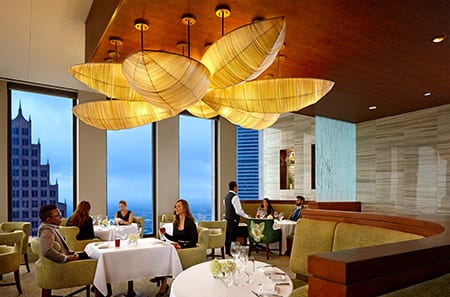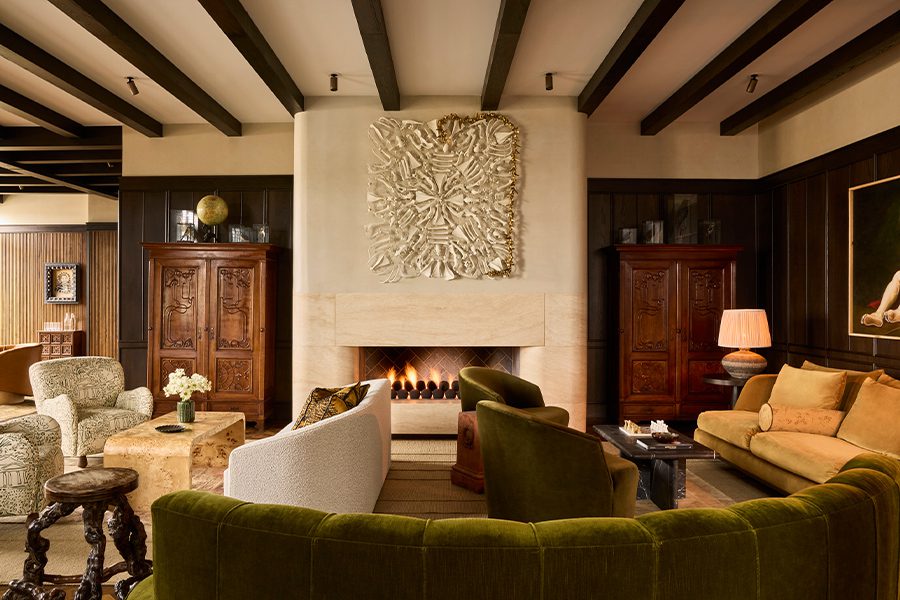Established 120 years ago, one of the oldest social clubs in the Southwest has made a move to continue its legacy as a haven for modern leaders. Texas’ Houston Club, established in 1894 and known for hosting members like former president George W. Bush, moved out of its original location last year and moved in with the Plaza Club atop Houston’s One Shell Plaza. Designed by Lisa Pope-Westerman, who works out of Gensler‘s Houston office, the newly combined social club stays true to its heritage while targeting a new generation.

“The club is divided into two zones-urban and suburban,” says Pope-Westerman, who notes that working with a split floorplan was a challenge. Overlooking the city skyline, the urban side has a “rugged individual character, with a comfortable, contemporary aesthetic,” she adds. “On the suburban side, the aesthetic is a little softer-more residential, yet sophisticated.” The 15,000-square-foot club holds two dining spaces, a ballroom, a boardroom, and several private and co-working spaces-the design of each honoring Houston.

A curved, copper ceiling element in the lobby echoes an oil and gas pipeline, reminiscent of the city’s role as the energy capital of the world. This heritage continues in a co-working space in the urban zone dubbed the Energy Room. “While we wanted to pay homage to the club’s history, we also wanted to add contemporary touches that appeal to 21st century leaders,” explains Pope-Westerman. “The Energy Room also evokes the dynamism of today’s energy industry.”

In contrast, the boardroom offers the most formal meeting space. “It is private, intimate, and masculine,” says Pope-Westerman. Throughout, murals of the Houston skyline and the deck of an oil tanker adorn the walls. The Saddle Lounge and the Bayou Room are private diving rooms that also function as conference rooms. A graphic of an oil tanker backs the lounge and the Bayou Room boasts wooden barn doors and a painting that echoes its namesake.

Similarly, Allen’s Landing restaurant harkens back to Houston’s origins. At the confluence of the White Oak Bayou and Buffalo Bayou, brothers Augustus C. and John K. Allen first landed at what would become Allen’s Landing, founding the city as it is known today. To recall this famous site, the restaurant takes after the prow of a ship. “It has a rustic, nautical quality,” says Pope-Westerman. “Our palette for the space is rich earth tones with stone accents, copper table tops, and amber pendant lighting.” Doors fashioned from wooden paddles lead into the space, which is covered in wide plank wooden floors.

In the Magnolia Room, the more formal of the two dining spaces that showcases a view of the city skyline, Houston’s Southern roots are recalled with the magnolia flowers upholstered on the backs of chairs. “The coolest feature is how the new design opens up the space to the spectacular view,” Pope-Westerman says. A large, abstracted magnolia blossom light, made of stretched, silky fabric in a bronze frame, adds to Houston Club’s natural sunlight and the modernized look.

“We blew the dust off a historic club and gave it a renewed vigor and appeal,” Pope-Westerman says. “The interiors are a careful blending of old and new, intended to appeal to club members of all ages.”


